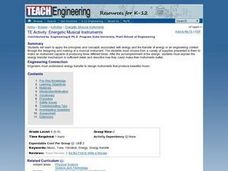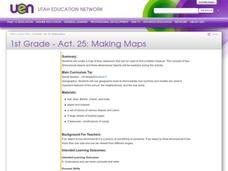Curated OER
Ethan Frome
Students can earn up to 50 points in Section I "C" Level. They can earn up to 10 points in Section "B" where students can complete only one activity. Students can earn a maximum of 20 points in Section "A" activities.
Curated OER
Cluing into Symbols Robert Frost
Learners use the Internet and video to discover how find evidence in poetry in order to discover the theme(s) of the poems. They are able to define poetic devices like simile, metaphor and repetition. Students identify themes in...
Curated OER
Language Arts: Stylistic Devices
Students are able to define given literary terms, such as metaphor, simile, imagery, personification, symbolism, etc. They are able to identify the use of literary elements in a given text. Students are able to interpret weather...
Curated OER
Personal Patriots
First graders review the Pledge of Allegiance and symbols of America. Students discuss the sequence used to say the Pledge of Allegiance. They practice reciting the Pledge of Allegiance. Students view symbols of things they know and...
Curated OER
Viewing Guide for The Ponder Heart
Students conduct research through library and Internet resources. They research in a multidisciplinary fashion, and make creative leaps in their analysis and interpretation of the novella.
Curated OER
Allegory in Painting
Young scholars define allegory and discuss its use in the visual arts, examine paintings from various time periods and identify allegorical themes in them, and explain what makes an image allegorical.
Curated OER
The Notorious Hope Diamond: What Makes an American Legend?
Students view and discuss a video on the legend of the Hope Diamond then compare and contrast other tales such as Paul Bunyan, Pecos Bill and Johnny Appleseed. They analyze basic characteristics of these legends then use descriptive...
Curated OER
Number the Stars, Lesson 10
Students analyze the literary element mood in Chapter 10 of the novel Number the Stars. They explain why the literary element mood is a feeling that a story creates in readers. Students share their thoughts on the topic of mood and its...
Curated OER
Literature: Satire in the American Dream
Eleventh graders examine cartoons for examples of satire, irony, and sarcasm. They write essays about cartoons, art work, or literature analyzing it for satirical elements. Finally, they create their own piece in one of the three areas...
Curated OER
Onomatopoeia
Students explore the use of onomatopoeia using comics. They develop a list of onomatopoeia examples, write sentences, complete a worksheet, and create a comic strip using onomatopoeias.
Curated OER
A Sense of Place
Students read "Fish Tale: Falling For a Live One" from The New York Times and discuss the methods and techniques the writer uses to create a strong mental image. Students pick a place in their community they wish to write about and...
Curated OER
Global Faith
Students review their prior knowledge of religious symbols and their meanings. After reading an article, they discover the comeback of the Muslim faith in Spain. In groups, they research and compare the evolutions of two religions in a...
Curated OER
Social Studies: African Banner Boxes
Students write creation stories and design stamps to use on banners accompany them. They discuss the use of stamps in African culture to take the place of words. Students use a handout of stamps and their own creations to create banners...
Curated OER
Energetic Musical Instruments
Students apply the principles and concepts associated with energy and the transfer of energy in an engineering context through the designing and making of a musical instrument. After the accomplishment of the design, students must...
Curated OER
ESL Network: Tezen, A Haitian Folktale
Sixth graders brainstorm various types of friendships prior to reading "Tezen," a tale about a young girl's friendship with a fish. After writing story reviews, they work in small groups to create dramatic skits based on the text and...
Curated OER
Rock & Roll through Literary Terms: An Upbeat Lyrical Adventure
Students participate in a variety of activities surrounding Rock & Roll music, lyrics, drama and visual art and how they all help demonstrate examples of literary terms. They use Rock & Roll as an effective aid to stimulate their...
Curated OER
Poetry: A Picture of Feelings
Students take a field trip to a place of interest. After the trip they share with a partner their most memorable memory about it. Later, they paint a picture representative of the trip and illustrate it with a poem using at least two...
Curated OER
Metaphorical Poetry
Twelfth graders read and discuss poems by Jewel., Sylvia Plath, and Langston Hughes They examine poems for examples of metaphors and similes. After discussing Jewel's poem Lost, they write their own poems. They hold a poetry reading in...
Curated OER
Analyzing Poetic Devices: Robert Hayden's "Those Winter Sundays" and Theodore Roethke's "My Papa's Waltz"
Students examine how Robert Hayden and Theodore Roethke incorporate poetic devices to convey meaning in the poems, 'Those Winter Sundays,' and 'My Papa's Waltz.' They listen to audio clips, explore websites, and write an analysis of the...
Curated OER
Design a Book Cover
Learners explore character, plot, setting, symbolism, and conflict for a book that they are reading. Sample book covers are provided and students apply what they have learned by designing a book cover.
Curated OER
Creating Your Own Rock Art
Fourth graders use regional rock art symbols or their own symbols to cooperatively create a rock art panel. They examine their feelings about rock art vandalism and discuss ways to protect rock art and other archaeological sites.
Curated OER
Flower Symbolism
Fourth graders identify flowers as symbols in art forms. They focus on the Victorian era and create their own flower design for use in visual art or literary forms.
Curated OER
Poetry, Take Me Away!
Students explore a variety of poetry and poetry concepts. They examine figurative language, mood, and literary devices. The students write and recite their own poetry.
Curated OER
Making Maps
First graders create a map of their classroom that can be used to find a hidden treasure. They examine two- and three-dimensional objects and discover characteristics.

























